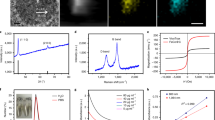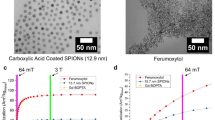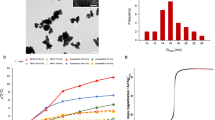Abstract
Silicon-based micro- and nanoparticles have gained popularity in a wide range of biomedical applications due to their biocompatibility and biodegradability in vivo, as well as their flexible surface chemistry, which allows drug loading, functionalization and targeting. Here, we report direct in vivo imaging of hyperpolarized 29Si nuclei in silicon particles by magnetic resonance imaging. Natural physical properties of silicon provide surface electronic states for dynamic nuclear polarization, extremely long depolarization times, insensitivity to the in vivo environment or particle tumbling, and surfaces favourable for functionalization. Potential applications to gastrointestinal, intravascular and tumour perfusion imaging at subpicomolar concentrations are presented. These results demonstrate a new background-free imaging modality applicable to a range of inexpensive, readily available and biocompatible silicon particles.
This is a preview of subscription content, access via your institution
Access options
Subscribe to this journal
Receive 12 print issues and online access
$259.00 per year
only $21.58 per issue
Buy this article
- Purchase on Springer Link
- Instant access to full article PDF
Prices may be subject to local taxes which are calculated during checkout




Similar content being viewed by others
References
Nel, A., Xia, T., Madler, L. & Li, N. Toxic potential of materials at the nanolevel. Science 311, 622–627 (2006).
Jiang, W., Kim, B. Y. S., Rutka, J. T. & Chan, W. C. W. Nanoparticle-mediate cellular response is size-dependent. Nature Nanotech. 3, 145–150 (2008).
Xia, X. R., Monteiro-Riviere, N. A. & Riviere, J. E. An index for characterization of nanomaterials in biological systems. Nature Nanotech. 5, 671–675 (2010).
Park, J. H. et al. Biodegradable luminescent porous silicon nanoparticles for in vivo applications. Nature Mater. 8, 331–336 (2009).
Tasciotti, E. et al. Mesoporous silicon particles as a multistage delivery system for imaging and therapeutic applications. Nature Nanotech. 3, 151–157 (2008).
Tanaka, T. et al. Sustained small interfering RNA delivery by mesoporous silicon particles. Cancer Res. 70, 3687–3696 (2010).
Singh, N. et al. Bioresponsive mesoporous silica nanoparticles for triggered drug release. J. Am. Chem. Soc. 133, 19582–19585 (2011).
Mann, A. P. et al. E-selectin-targeted porous silicon particle for nanoparticle delivery to the bone marrow. Adv. Mater. 23, 278–282 (2011).
Tasciotti, E. et al. Near-infrared imaging method for the in vivo assessment of the biodistribution of nanoporous silicon particles. Mol. Imag. 10, 56–68 (2011).
Ananta, J. S. et al. Geometrical confinement of gadolinium-based contrast agents in nanoporous particles enhances T1 contrast. Nature Nanotech. 5, 815–821 (2010).
Gu, L. et al. Magnetic luminescent porous silicon microparticles for localized delivery of molecular drug payloads. Small 6, 2546–2552 (2010).
Tu, C. et al. PET imaging and biodistribution of silicon quantum dots in mice. ACS Med. Chem. Lett. 2, 285–288 (2011).
Albert, M. S. et al. Biological magnetic resonance imaging using laser-polarized 129Xe. Nature 370, 199–201 (1994).
Fain, S. et al. Functional lung imaging using hyperpolarized gas MRI. J. Magn. Reson. 25, 910–923 (2007).
Mair, R. W. et al. 3He lung imaging in an open access, very-low-field human magnetic resonance imaging system. Magn. Res. Med. 53, 745–749 (2005).
Day, S. E. et al. Detecting tumor response to treatment using hyperpolarized 13C magnetic resonance imaging and spectroscopy. Nature Med. 13, 1382–1387 (2007).
Gallagher, F. A. et al. Magnetic resonance imaging of pH in vivo using hyperpolarized 13C-labelled bicarbonate. Nature 453, 940–943 (2008).
Zacharias, N. M. et al. Real-time molecular imaging of tricarboxylic acid cycle metabolism in vivo by hyperpolarized 1–13C diethyl succinate. J. Am. Chem. Soc. 134, 934–943 (2011).
Keshari, K. R. et al. Hyperpolarized 13C dehydroascorbate as an endogenous redox sensor for in vivo metabolic imaging. Proc. Natl Acad. Sci. USA 108, 18606–18611 (2011).
Walker, T. G. & Happer, W. Spin-exchange optical pumping of noble-gas nuclei. Rev. Mod. Phys. 69, 629–642 (1997).
Ardenkjaer-Larsen, J. H. et al. Increase in signal-to-noise ratio of >10,000 times in liquid-state NMR. Proc. Natl Acad. Sci. USA 100, 10158–10163 (2003).
Hall, D. A., Maus, D., Gerfen, G. J. & Griffin, R. G. Polarization-enhanced NMR spectroscopy of biomolecules in frozen solution. Science 276, 930–932 (1997).
Golman, K. et al. Molecular imaging with endogenous substances. Proc. Natl Acad. Sci. USA 100, 10435–10439 (2003).
Shulman, R. G. & Wyluda, B. J. Nuclear magnetic resonance of Si29 in n and p type silicon. Phys. Rev. 103, 1127–1129 (1956).
Aptekar, J. W. et al. Silicon nanoparticles as hyperpolarized magnetic resonance imaging agents. ACS Nano 3, 4003–4008 (2009).
Ladd, T. D. et al. Coherence time of decoupled nuclear spins in silicon. Phys. Rev. B 71, 014401 (2005).
Dementyev, A. E., Cory, D. G. & Ramanathan, C. Dynamic nuclear polarization in silicon microparticles. Phys. Rev. Lett. 100, 127601 (2008).
Godin, B. et al. Tailoring the degradation kinetics of mesoporous silicon structures through PEGylation. J. Biomed. Mater. Res. A 94, 1236–1243 (2010).
Lee, M., Cassidy, M. C., Ramanathan, C. & Marcus, C. M. Decay of nuclear hyperpolarization in silicon microparticles. Phys. Rev. B 84, 035304 (2011).
Abragam, A. Principles of Nuclear Magnetism (Oxford Univ. Press, 1983).
Bouchard, L. S. et al. Picomolar sensitivity MRI and photoacoustic imaging of cobalt nanoparticles Proc. Natl Acad. Sci. USA 106, 4085–4089 (2009).
Ahrens, E. T., Flores, R., Xu, H. & Morel, P. A. In vivo imaging platform for tracking immunotherapeutic cells. Nature Biotechnol. 23, 983–987 (2005).
Bonetto, F. et al. A novel 19F agent for detection and quantification of human dendritic cells using magnetic resonance imaging. Int. J. Cancer 129, 365–373 (2011).
Umschaden, H. W. et al. Small-bowel disease: comparison of MR enteroclysis images with conventional enteroclysis and surgical findings. Radiology 215, 717–725 (2000).
Jugdaohsingh, R. et al. Dietary silicon intake is positively associated with bone mineral density in men and premenopausal women of the Framingham Offspring cohort. J. Bone Miner. Res. 19, 297–307 (2004).
Canham, L. T. Nanoscale semiconducting silicon as a nutritional food additive. Nanotechnology 18, 185704 (2007).
US Food and Drug Administration Food Additives Permitted for Direct Addition to Food for Human Consumption—Anticaking Agents, 21CFR172.480 (US FDA, 2011).
Thakor, A. S. et al. The fate and toxicity of Raman-active silica–gold nanoparticles in mice. Sci. Transl. Med. 3, 79–33 (2011).
Gerion, D. et al. Synthesis and properties of biocompatible water-soluble silica-coated CdSe/ZnS semiconductor quantum dots. J. Phys. Chem. B 105, 8861–8871 (2001).
Selvan, S. T., Patra, P. K., Ang, C. Y. & Ying, J. Y. Synthesis of silica-coated semiconductor and magnetic quantum dots and their use in the imaging of live cells. Angew. Chem. Int. Ed. 46, 2448–2452 (2007).
Atkins, T. M. et al. Synthesis of long-T1 silicon nanoparticles for hyperpolarized 29Si magnetic resonance imaging. ACS Nano 7, 1609–1617 (2013).
Cassidy, M. C. Hyperpolarized Silicon Particles as In Vivo Imaging Agents. PhD thesis, Harvard Univ. (2012).
McCamey, D. R., van Tol, J., Morley, G. W. & Boehme, C. Fast nuclear spin hyperpolarization of phosphorus in silicon. Phys. Rev. Lett. 102, 027601 (2009).
Bagraev, N. T., Vlasenko, L. S. & Zhitnikov, R. A. Optical orientation of Si29 nuclei in compensated silicon. Sov. Phys. JETP Lett. 23, 586–589 (1976).
Wolber, J. et al. Spin-lattice relaxation of laser-polarized xenon in human blood. Proc. Natl Acad. Sci. USA 96, 3664–3669 (1999).
Schroder, L., Lowery, T. J., Hilty, C., Wemmer, D. E. & Pines, A. Molecular imaging using a targeted magnetic resonance hyperpolarized biosensor. Science 314, 446–449 (2006).
Lanza, G. et al. 1H/19F Magnetic resonance molecular imaging with perfluorocarbon nanoparticles. In Vivo Cell. Mol. Imag. 70, 57–76 (2005).
Lustig, M., Donoho, D. & Pauly, J. M. Sparse MRI: the application of compressed sensing for rapid MR imaging. Magn. Res. Med. 58, 1182–1195 (2007).
Zhao, L. et al. Gradient-echo imaging considerations for hyperpolarized 129Xe MR. J. Magn. Reson. B 113, 179–183 (1996).
Li, D., Dementyev, A. E., Dong, Y., Ramos, R. G. & Barrett, S. E. Generating unexpected spin echoes in dipolar solids with π pulses. Phys. Rev. Lett. 98, 190401 (2007).
Acknowledgements
This research is supported by the National Institutes of Health (NIH, 1R21 CA118509, 1R01NS048589), the National Cancer Institute (NCI, 5R01CA122513), the Tobacco Related Disease Research Program (TRDRP, 16KT-0044), the National Science Foundation (BISH, CBET-0933015), and the National Science Foundation through the Harvard Nanoscale Science and Engineering Center. M.C.C. acknowledges financial support from the R.G. Menzies Foundation. The authors thank L.W. Jones for the gift of the TRAMP animals, N. Zacharias for assistance with histology, M. Lee, L. Robertson and B.D. Armstrong for assistance with the initial stages of the experiment and L.W. Jones, C. Ramanathan and R.W. Mair for many helpful discussions.
Author information
Authors and Affiliations
Contributions
M.C.C., P.K.B. and C.M.M. designed the experiments. M.C.C., H.R.C. and P.K.B. performed the experiments. B.D.R. provided consultation on animal techniques. M.C.C. and C.M.M. co-wrote the paper.
Corresponding author
Ethics declarations
Competing interests
The authors declare no competing financial interests.
Supplementary information
Supplementary information
Supplementary information (PDF 3622 kb)
Rights and permissions
About this article
Cite this article
Cassidy, M., Chan, H., Ross, B. et al. In vivo magnetic resonance imaging of hyperpolarized silicon particles. Nature Nanotech 8, 363–368 (2013). https://doi.org/10.1038/nnano.2013.65
Received:
Accepted:
Published:
Issue Date:
DOI: https://doi.org/10.1038/nnano.2013.65
This article is cited by
-
Ultrasmall Fe3O4 and Gd2O3 hybrid nanoparticles for T1-weighted MR imaging of cancer
Cancer Nanotechnology (2022)
-
Acquisition strategies for spatially resolved magnetic resonance detection of hyperpolarized nuclei
Magnetic Resonance Materials in Physics, Biology and Medicine (2020)
-
Clinical Cardiovascular Applications of Hyperpolarized Magnetic Resonance
Cardiovascular Drugs and Therapy (2020)
-
Phase-Encoded Hyperpolarized Nanodiamond for Magnetic Resonance Imaging
Scientific Reports (2019)
-
Electrically controlled nuclear polarization of individual atoms
Nature Nanotechnology (2018)



